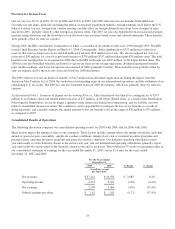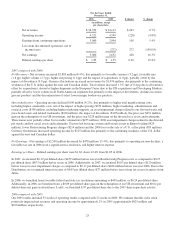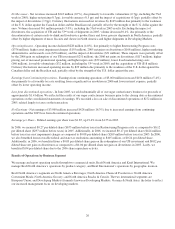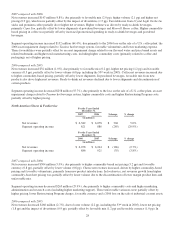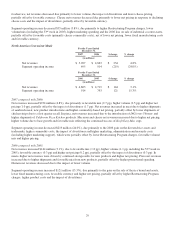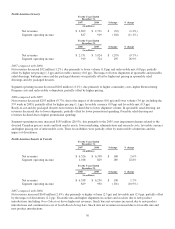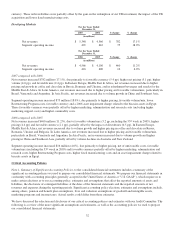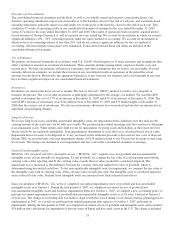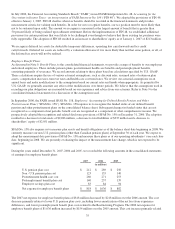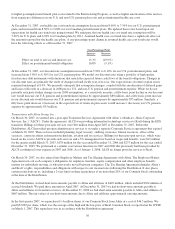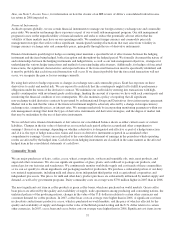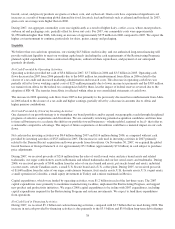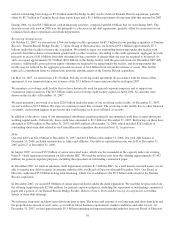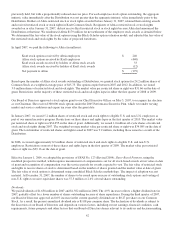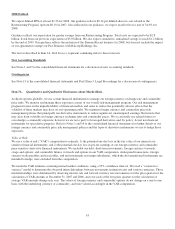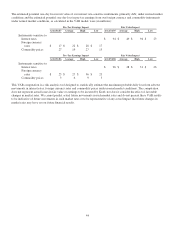Kraft 2007 Annual Report Download - page 49
Download and view the complete annual report
Please find page 49 of the 2007 Kraft annual report below. You can navigate through the pages in the report by either clicking on the pages listed below, or by using the keyword search tool below to find specific information within the annual report.in asset impairment and exit costs in the consolidated statement of earnings. During the first quarter of 2005, we completed our
annual review of goodwill and intangible assets. No impairments resulted from this review.
During the fourth quarter of 2007, we acquired goodwill of $5,239 million and intangible assets of $2,196 million as part of the
Danone Biscuit acquisition. These amounts represent the preliminary allocation of purchase price and are subject to revision
when appraisals are finalized, which will occur during 2008. The application of FAS No. 141, Business Combinations, requires
a number of significant judgments including the valuation of the cost of the acquisition and the assignment of such costs based
on the estimated fair values of assets acquired and liabilities assumed.
Insurance & Self-Insurance:
We use a combination of insurance and self-insurance for a number of risks, including workers’ compensation, general liability,
automobile liability, product liability and our obligation for employee healthcare benefits. Liabilities associated with the risks
are estimated by considering historical claims experience and other actuarial assumptions.
Revenue Recognition:
We recognize revenues when title and risk of loss pass to customers, which occurs upon shipment or delivery of goods.
Revenues are recorded net of consumer incentives and trade promotions and include all shipping and handling charges billed to
customers. Kraft’s shipping and handling costs are classified as part of cost of sales. We also record provisions and allowances
for estimated sales returns and bad debts in our consolidated financial statements. The amounts recorded for these provisions
and related allowances are not significant to our financial statements.
Marketing costs:
We promote our products with advertising, consumer incentives and trade promotions. These programs include, but are not
limited to, discounts, coupons, rebates, in-store display incentives and volume-based incentives. We expense advertising costs
either in the period the advertising first takes place or as incurred. Consumer incentive and trade promotion activities are
recorded as a reduction of revenues based on amounts estimated as being due to customers and consumers at the end of a period.
We base these estimates principally on historical utilization and redemption rates. For interim reporting purposes, advertising
and consumer incentive expenses are charged to operations as a percentage of volume, based on estimated volume and related
expense for the full year. We do not defer costs on our year-end consolidated balance sheet and all marketing costs are recorded
as an expense in the year incurred.
Environmental Costs:
We are subject to laws and regulations relating to the protection of the environment. We accrue for environmental remediation
obligations on an undiscounted basis when amounts are probable and can be reasonably estimated. The accruals are adjusted as
new information develops or circumstances change. Recoveries of environmental remediation costs from third parties are
recorded as assets when their receipt is deemed probable. As of December 31, 2007, our subsidiaries were involved in 70 active
Superfund and other similar actions in the U.S. related to current operations and certain former or divested operations for which
we retain liability.
Based on information currently available, we believe that the ultimate resolution of existing environmental remediation actions
and our compliance in general with environmental laws and regulations will not have a material effect on our financial results.
However, we cannot quantify with certainty the potential impact of future compliance efforts and environmental remediation
actions.
Income Taxes:
We account for income taxes in accordance with SFAS No. 109, Accounting for Income Taxes. Prior to the Distribution, we
were included in Altria’s consolidated federal income tax return. We generally computed income taxes on a separate company
basis; however some of our foreign tax credits, capital losses and other credits could not have been used on a separate company
basis. To the extent that Altria used our foreign tax credits and other tax benefits in its consolidated federal income tax return,
we recognized the benefit in the calculation of our provision for income taxes. This benefit was approximately $270 million in
2007 (both through the date of Distribution as well as post-Distribution carryback claims to pre-Distribution periods),
$195 million in 2006 and $225 million in 2005. We made payments to, or were reimbursed by, Altria for the tax effects
resulting from being included in Altria’s tax return. As of March 31, 2007, we are no longer a member of the Altria consolidated
tax return group and will file our own federal consolidated income tax return.
34


